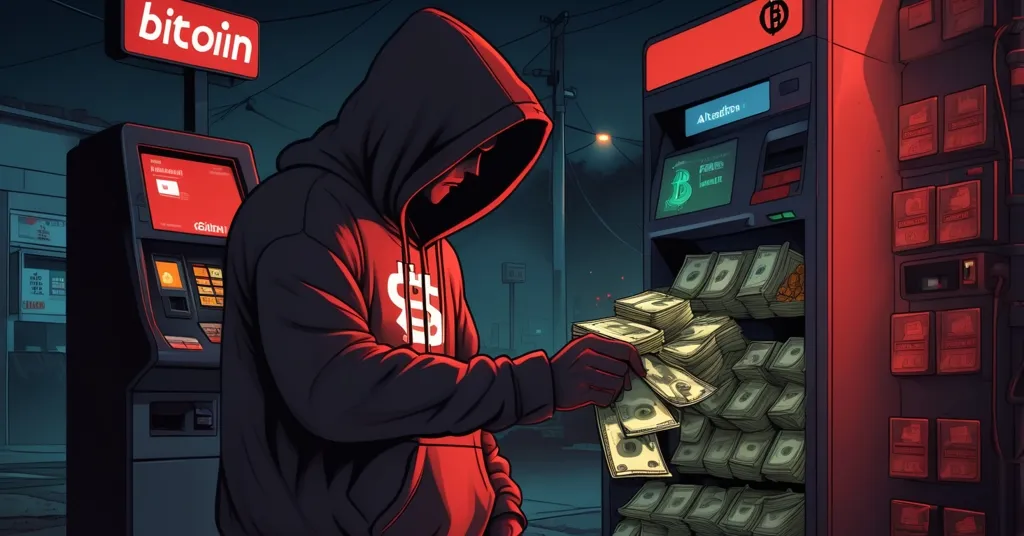Bitcoin ATM CEO Charged in $10M Laundering Scheme: Crypto’s Compliance Crisis Exposed

Bitcoin ATM Operator Charged in $10M Money Laundering Scandal: A Wake-Up Call for Crypto
Firas Isa, the 36-year-old founder and CEO of Virtual Assets LLC, operating as Crypto Dispensers, has been charged by the U.S. Department of Justice (DOJ) with laundering over $10 million in illicit funds through Bitcoin ATMs across the United States. Prosecutors allege that Isa knowingly processed proceeds from wire fraud and narcotics offenses, turning dirty cash into cryptocurrency to cloak its origins. This case not only spotlights one operator’s alleged misdeeds but also exposes deep cracks in crypto infrastructure while coinciding with a pivotal shift in U.S. crypto enforcement strategies.
- Core Charge: Firas Isa accused of laundering $10M via Bitcoin ATMs tied to wire fraud and drug crimes.
- Systemic Issue: Highlights KYC and AML compliance gaps in Bitcoin ATM operations.
- DOJ Pivot: Enforcement shifts from broad crackdowns to targeted strikes on major crypto crime.
The Charges Against Firas Isa: A Digital Laundromat?
The accusations against Isa are as serious as they get in the crypto space. Prosecutors claim that between 2020 and 2024, he and his company, Virtual Assets LLC, funneled over $10 million in illicit proceeds through a network of Bitcoin ATMs under the Crypto Dispensers brand. These machines, often found in gas stations, convenience stores, and currency exchanges across the U.S., allegedly served as a pipeline for cash from wire fraud schemes and narcotics trafficking to be converted into cryptocurrency, making it damn near impossible to trace without specialized tools. Isa faces a money laundering conspiracy charge, which carries a potential 20-year prison sentence if he’s convicted. Both he and his company have pleaded not guilty, with a status hearing scheduled for January 30, 2026, before U.S. District Judge Elaine E. Bucklo in the Northern District of Illinois.
For those new to the scene, Bitcoin ATMs are physical kiosks that let users buy or sell Bitcoin and sometimes other cryptocurrencies using cash or debit cards. They’re a bridge between the fiat world and the digital one, often marketed as a tool for the unbanked or those wary of traditional financial systems. But here’s the rub: unlike centralized exchanges like Coinbase or Binance, many Bitcoin ATMs operate with minimal oversight. Know-your-customer (KYC) rules, which require businesses to verify user identities, and anti-money laundering (AML) protocols, meant to flag suspicious transactions, are often weakly enforced in this space. Prosecutors allege Isa exploited this gray zone, allowing criminals to dump stacks of dirty cash and walk away with Bitcoin in digital wallets, effectively laundering money with the ease of buying a soda from a vending machine.
Bitcoin ATMs: Innovation or Vulnerability?
Let’s cut through the noise: Bitcoin ATMs are both a blessing and a curse. On one hand, they’re a tangible on-ramp to cryptocurrency, democratizing access for people who might not trust or have access to online exchanges. As of 2025, over 30,000 Bitcoin ATMs operate globally, with the U.S. hosting the lion’s share, according to Coin ATM Radar. They’re a symbol of crypto’s push for financial inclusion, a middle finger to the banking system that’s left millions behind. On the other hand, they’re a magnet for illicit operators when oversight is a joke. Criminals can stroll up, feed in cash from drug deals or scams, and get Bitcoin that’s tough to track unless law enforcement deploys sophisticated blockchain analysis—a process where experts use software to trace transactions on public ledgers like Bitcoin’s to spot suspicious patterns.
Isa’s case isn’t an isolated incident. Bitcoin ATMs have been linked to money laundering before, with the Financial Crimes Enforcement Network (FinCEN) issuing guidance as far back as 2021 warning operators to tighten up AML controls. Yet, compliance remains spotty. Some reports suggest a significant chunk of ATM operators fail to meet even basic KYC standards, leaving the door wide open for fraudsters and syndicates. If Isa’s conviction sticks, expect the fallout to hit hard—asset forfeiture could strip him of wealth, and regulators might clamp down on every Bitcoin ATM operator in the country. The crypto industry, already nursing bruises from endless scams and hacks, can’t afford another gut punch like this. But let’s be real: without some accountability, these machines risk becoming the poster child for “crypto crime” in the public eye.
DOJ’s New Crypto Playbook: Less Sledgehammer, More Scalpel
Zooming out, Isa’s case lands at a turning point for how the U.S. tackles cryptocurrency crime. In April 2025, the DOJ made a bold move by disbanding the National Cryptocurrency Enforcement Team (NCET), a unit once tasked with hunting down every digital asset misstep. The message was loud and clear: stop using a sledgehammer to crack walnuts. No more overreaching into the business of legit exchanges or wallets with petty prosecutions. Instead, the focus is shifting to heavyweight threats like terrorism and organized crime. Deputy Attorney General Todd Blanche laid it out in a memo that’s been circulating widely:
The Department will stop participating in regulation by prosecution in this space.
This pivot, as noted by legal observers on social media, marks a departure from blanket crackdowns toward precision strikes on the worst offenders. It’s a pragmatic shift—crypto isn’t vanishing anytime soon, and alienating an entire industry with heavy-handed tactics hasn’t won the feds any fans. Resources are now funneled into initiatives like the Scam Center Strike Force, a DOJ-led operation based in Washington, D.C. Partnering with the FBI, Secret Service, and treasury agencies, this task force targets overseas crypto fraud, including the sinister “pig butchering” scams. These schemes, often run by syndicates in Southeast Asia, involve fraudsters building trust with victims over weeks—think of it as a con artist charming you with fake romance or investment promises before draining your accounts. The Strike Force has already recovered over $400 million from such networks, a staggering figure that underscores both the scale of the problem and the potential of coordinated action.
Here’s the kicker: these scams often rely on cash-to-crypto tools like Bitcoin ATMs to launder victim funds, a tactic prosecutors allege Isa enabled. While the Strike Force focuses on cross-border crime, cases like this show how local infrastructure can fuel global fraud. The DOJ’s recalibration offers a sliver of hope that they’re learning to distinguish between innovation and exploitation, but it also raises the stakes for domestic operators. If Bitcoin ATMs are seen as low-hanging fruit for laundering scam proceeds, the regulatory hammer could still swing hard, innovation be damned.
Playing Devil’s Advocate: Freedom vs. Accountability
Now, let’s flip the script for a moment. As a Bitcoin maximalist with a soft spot for decentralization, I can’t help but cheer the DOJ backing off from “regulation by prosecution.” Bitcoin was built to sidestep centralized control, to give power back to individuals, and overpolicing tools like ATMs could choke the very freedom it stands for. I’m all for effective accelerationism—pushing tech forward without bureaucratic drag. Why should a few bad apples spoil the whole barrel? Bitcoin’s blockchain itself is transparent, auditable, and safer than cash when used right. The problem isn’t the tech; it’s the off-ramps and on-ramps where filth creeps in.
But here’s the counterpunch: ignoring these exploits hands ammo to skeptics who paint crypto as a Wild West, a haven for illicit operators, and a risk to financial stability. Some might argue that stricter ATM rules protect consumers more than they hinder liberty, and they’re not entirely wrong. Cases like Isa’s fuel narratives that could justify smothering crypto before it scales. The balance between freedom and accountability isn’t just a catchy phrase—it’s the tightrope the industry must walk. Without some guardrails, we risk losing the trust needed for mass adoption. Yet, overdo it, and we betray the ethos of decentralization. So, where do we draw the line?
What’s Next for Crypto Regulation and Bitcoin ATMs?
The implications of Isa’s case stretch far beyond one man or one company. A conviction could set a precedent for how Bitcoin ATM operators are policed, potentially forcing them to adopt stricter KYC and AML controls or face crippling fines. For an industry that thrives on accessibility and user autonomy, that’s a bitter pill to swallow. Imagine needing to upload your ID and life story just to buy $50 worth of Bitcoin at a corner store—hardly the borderless vision Satoshi had in mind. Yet, if we’re brutally honest, some oversight is overdue. Decentralization doesn’t mean a free pass for crime, and public perception matters as much as tech purity when it comes to adoption.
At the same time, the DOJ’s broader pivot offers cautious optimism. Focusing on global scams over local startups suggests a nuanced understanding that not all crypto players are villains. Political and economic factors—like upcoming elections or budget constraints—could further shape this approach, especially as Bitcoin gains traction as a hedge against inflation while altcoins and DeFi platforms carve out their own niches. Will this balance hold, or will the next high-profile scandal tip the scales back toward overreach? For now, all eyes are on a Chicago courtroom in 2026, where Firas Isa’s fate could ripple through the cash-to-crypto frontier.
Despite these scandals, Bitcoin’s core tech remains untainted—a testament to its design as the ultimate middle finger to centralized failures. The challenge isn’t the protocol; it’s the messy human layer around it. As we navigate these growing pains, cases like this serve as both a warning and a call to action for the community to clean house before regulators do it for us—with far less finesse.
Key Takeaways and Questions on Bitcoin ATM Money Laundering
- What crimes is Firas Isa accused of, and how do Bitcoin ATMs factor in?
Isa faces a money laundering conspiracy charge for allegedly processing over $10 million from wire fraud and narcotics trafficking through Bitcoin ATMs under his Crypto Dispensers brand, using the machines to convert illicit cash into hard-to-trace cryptocurrency. - Why are Bitcoin ATMs a weak link in crypto infrastructure?
Many lack robust KYC and AML compliance, making it easy for criminals to anonymize dirty money into digital wallets, a vulnerability prosecutors claim Isa exploited. - How is U.S. crypto enforcement evolving, and what does it mean for Bitcoin?
The DOJ dissolved the NCET to prioritize major crimes like terrorism, launching the Scam Center Strike Force to tackle overseas fraud, signaling less overreach on legit businesses but a fierce focus on global scams—potentially sparing Bitcoin innovation from undue scrutiny. - What could Isa’s case mean for Bitcoin ATM operators and crypto regulation?
A conviction might trigger harsher AML rules and oversight for Bitcoin ATMs, balancing accessibility with accountability, though excessive regulation risks stifling the decentralized ethos of crypto. - Can the DOJ’s Scam Center Strike Force reshape the fight against crypto crime?
With over $400 million recovered from scams like “pig butchering,” it shows promise in addressing cross-border fraud tied to tools like Bitcoin ATMs, potentially improving crypto’s reputation without suffocating the industry.



